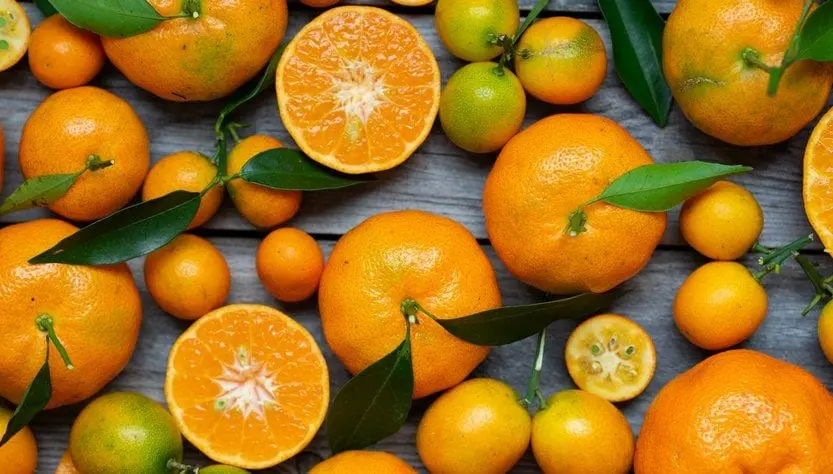Contents
Description
The famous orange fruit is loved by many not only for its taste. Orange has many useful properties known to traditional medicine. We will learn how to eat fruit correctly, and who needs to treat it with caution.
The history of the orange
Orange is the most famous and widespread citrus. The fruits grow on an evergreen tree. Orange flowers are large, pleasantly smelling, they are collected for tea or sachets. According to some botanists’ assumptions, an orange may be a hybrid of a pomelo and a mandarin.
The original orange tree looked very different. It was low, covered with thorns and had a bitter-sour fruit. They were not eaten, but trees began to be cultivated because of the beautiful bright color of the fruits. It happened in China in 2300 BC. Gradually, the Chinese crossed trees with the brightest and sweetest fruits, and got new varieties.
In Europe, the orange was recognized only in the 15th century. Everyone appreciated the unusual and beautiful fruit, and made attempts to grow the tree in the new climate. For this, it was necessary to build special greenhouses that protect the overseas fruit from the cold. They were called greenhouses (from the word orange – “orange”).
We borrowed the Russian name “orange” from the Dutch. They called it “appelsien” – which literally translates as “apple from China.”
The main suppliers of oranges are still countries with hot tropical and subtropical climates: India, China, Brazil, and the warm states of America. In countries with cold climates, oranges can only be grown in greenhouses, as the trees freeze outdoors.
The composition and calorie content

- Caloric content 43 kcal
- Proteins 0.9 g
- Fat 0.2 g
- Carbohydrates 8.1 g
- Dietary fiber 2.2 g
- Water 87 g
How to choose sweet oranges
- Look at the peel – the color should be uniform and bright. The peel of a good sweet orange is smooth and has small blotches of red;
- The fruit should not be soft, loose or deformed;
- Delicious and sweet oranges should be juicy, and therefore weighty – choose heavier fruits. Be sure to smell – ripe fruits have a bright aroma.
- If you find oranges with a pronounced navel (the top of the fruit), then surely such a fruit will be tasty and sweet.
- Don’t buy oversized oranges – they usually don’t taste good.
The benefits of an orange
Orange is extremely useful for vitamin deficiency, as it contains many vitamins in high concentration: C, A, E, B vitamins.
The pectin and fiber in the orange help with various diseases of the stomach and intestines. They envelop the mucous membrane, accelerate peristalsis in case of constipation, nourish beneficial microorganisms in the intestines. By the way, it is pectin that gives orange jam such a jelly-like structure.
Also, orange juice is drunk with food to stimulate appetite, which will help to eat the right amount of food during illness. The phytoncides in this fruit have an antibacterial effect. If you eat half an orange during a cold, weakness and weakness will recede a little, and you will recover faster.

Orange is called a sunny fruit for a reason – it has a scientific basis. The fruit’s rind contains essential oils that are often used in aromatherapy and are added to various ointments. Orange oil has a relaxing, sedative effect while improving mood. The smell of orange is statistically the third most popular fragrance. It is second only to chocolate and vanilla.
The positive effect of orange on the heart and blood vessels is also known. Anthocyanins in this fruit have an antioxidant effect, protecting cells from the harmful oxidative process. Flavonoids reduce the risk of cardiovascular disease by decreasing vascular fragility. They also prevent blood clots by inhibiting blood clotting and increasing the elasticity of red blood cells.
Harm
Any citrus fruits are a strong allergen; this fruit should not be given to children under one year old. Non-allergy sufferers can be given to taste oranges after a year, allergy-prone children – not earlier than three years.
Orange has a high acidity, which is bad for tooth enamel. For those who have problems with enamel and the risk of its destruction is high, it is better to rinse your mouth after eating an orange. Alternatively, you can drink the juice through a straw to protect your teeth.
For the same reason, drinking freshly squeezed orange juice on an empty stomach or eating fruit is not worth it for people suffering from ulcers, gastritis, high acidity of gastric juice. Better to eat fruit after eating, and only in remission
The use of orange in medicine

Modern medicine uses mainly orange oil extracted from the peel. It is actively used in aromatherapy and is added to various cosmetics.
Drinking juice and eating oranges is also recommended for weakened people with vitamin deficiencies. Oranges are also useful for retention of bile, urine, constipation; since the fruits have light urine – a choleretic effect and accelerate intestinal peristalsis.
The popular ability of the orange to “burn fat” during the orange diet is not scientifically supported. Indeed, the naringin substance in this fruit can reduce appetite and force the liver to start fat burning processes.
But in a small dose, this effect is not noticeable at all, and a couple of oranges, on the contrary, will awaken the appetite. Eating a few dozen fruits for the sake of losing weight is unlikely to be a smart decision.
In folk medicine, the leaves, orange peel are used in the form of decoctions as a sedative.
The use of orange in cooking
In Russia, the orange is used mainly in sweet dishes, jams, pies, cocktails. But in other countries, the pulp is fried, added to various salty and spicy dishes.
They eat not only the pulp and juice from it, but also the peels themselves – you can make candied fruits from them, extract fragrant oil.
Orange pie

Ingredients
- Eggs – 3 pieces
- Flour – 150 gr
- Sugar – 180 gr
- Orange – 1 piece
- Vegetable oil – half a teaspoon
- Powdered sugar – 1 tablespoon
- Salt – a pinch
- Baking powder – 1 tsp
Cooking
- Wash the orange thoroughly and grate the zest with a fine grater, without touching the white part – it tastes bitter. You can also cut the zest with a peeler and chop it into thin strips with a knife. Next, peel the orange, remove the pulp and peel it of films and seeds. Cut the peeled pulp into small cubes.
- Break eggs into a bowl and beat with sugar until fluffy with a mixer or whisk. Add salt, baking powder, zest, mix. Gradually introduce the sifted flour, continuing to beat the dough at low speed.
- Add the orange cubes, stir gently with a spoon, and pour the dough into a greased mold. Bake in an oven preheated to 180 degrees for about half an hour.
- After allowing the cake to cool, then remove from the mold and sprinkle with powdered sugar before serving.










Write more, thats all I have to say. Literally, it seems
as though you relied on the video to make your point.
You definitely know what youre talking about, why throw away
your intelligence on just posting videos to your weblog when you could be giving us something informative to read?